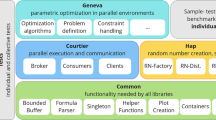Abstract
With the rapid development of network technology and parallel computing, clusters formed by connecting a large number of PCs with high-speed networks have gradually replaced the status of supercomputers in scientific research and production and high-performance computing with cost-effective advantages. The research purpose of this paper is to integrate the Kriging proxy model method and energy efficiency modeling method into a cluster optimization algorithm of CPU and GPU hybrid architecture. This paper proposes a parallel computing model for large-scale CPU/GPU heterogeneous high-performance computing systems, which can effectively describe the computing capabilities and various communication behaviors of CPU/GPU heterogeneous systems, and finally provide algorithm optimization for CPU/GPU heterogeneous clusters. According to the GPU architecture, an efficient method of constructing a Kriging proxy model and an optimized search algorithm are designed. The experimental results in this paper show that the construction of the Kriging proxy model can obtain a 220 times speedup ratio, and the search algorithm can reach an 8 times speedup ratio. It can be seen that this heterogeneous cluster optimization algorithm has high feasibility.






Similar content being viewed by others
Data availability
No data were used to support this study.
References
Vidal, P., Alba, E., Luna, F.: Solving optimization problems using a hybrid systolic search on GPU plus CPU. Soft Comput. 21(12), 3227–3245 (2017)
Young, S., Lo, P., Hoffman, J., et al.: TH-AB-207A-05: a fully-automated pipeline for generating CT images across a range of doses and reconstruction methods. Med. Phys. 43(6), 3860–3860 (2016)
John, J., Rodrigues, P.: MOTCO: multi-objective Taylor crow optimization algorithm for cluster head selection in energy aware wireless sensor network. Mob. Netw. Appl. 24(5), 1509–1525 (2019)
Feng, Z., Zhai, J., He, B., et al.: Understanding co-running behaviors on integrated CPU/GPU architectures. IEEE Trans. Parallel Distrib. Syst. 28(3), 905–918 (2017)
Fursov, V.A., Goshin, Y.V., Kotov, A.P.: The hybrid CPU/GPU implementation of the computational procedure for digital terrain models generation from satellite images. Comput. Opt. 40(5), 721–728 (2016)
Liang, T.-Y., Li, H.-F., et al.: A distributed PTX virtual machine on hybrid CPU/GPU clusters. J. Syst. Archit. 62(1), 63–77 (2016)
Goli, M., González-Vélez, H.: Autonomic coordination of skeleton-based applications over CPU/GPU multi-core architectures. Int. J. Parallel Program. 45(2), 1–22 (2017)
Li, H.F., Liang, T.Y., Lin, Y.J.: An OpenMP programming toolkit for hybrid CPU/GPU clusters based on software unified memory. J. Inf. Sci. Eng. 32(3), 517–539 (2016)
Zhang, F., Hu, C., Li, W., et al.: A deep collaborative computing based SAR raw data simulation on multiple CPU/GPU platform. IEEE J. Sel. Top. Appl. Earth Obs. Remote Sens. 10(99), 387–399 (2017)
Lai, J., Tian, Z., et al.: Numerical investigation of supersonic transverse jet interaction on CPU/GPU system. J. Braz. Soc. Mech. Sci. Eng. 42(2), 1–13 (2020)
Kazmi, R., Bajwa, I.S.: High-performance simulation of drug release model using finite element method with CPU/GPU platform. J. Univers. Comput. Sci. 25(10), 1261–1278 (2019)
Le, T.N., Sun, X., Chowdhury, M., et al.: AlloX: allocation across computing resources for hybrid CPU/GPU clusters. ACM SIGMETRICS Perform. Eval. Rev. 46(2), 87–88 (2019)
Iacovella, S., Ruelens, F., Vingerhoets, P., et al.: Cluster control of heterogeneous thermostatically controlled loads using tracer devices. IEEE Trans. Smart Grid 8(2), 528–536 (2017)
Satyajeet, D., Deshmukh, A.R., Dorle, S.S.: Heterogeneous approaches for cluster based routing protocol in vehicular ad hoc network (VANET). Int. J. Comput. Appl. 134(12), 1–8 (2016)
Arroyo, I., Giné, F., Roig, C., et al.: Analyzing google earth application in a heterogeneous commodity cluster display wall. Multimed. Tools Appl. 75(18), 11391–11416 (2016)
Eicker, N., Lippert, T., Moschny, T., et al.: The DEEP project an alternative approach to heterogeneous cluster-computing in the many-core era. Concurr. Comput. Pract. Exp. 28(8), 2394–2411 (2016)
Chu, J.F., Wu, J., Song, M.L.: An SBM-DEA model with parallel computing design for environmental efficiency evaluation in the big data context: a transportation system application. Ann. Oper. Res. 270(1), 105–124 (2018)
Liu, X., Yang, N., Jiang, Y., et al.: A parallel computing-based deep attention model for named entity recognition. J. Supercomput. 76(2), 814–830 (2020)
D’Auriol, B.J.: All-optical linear array with a reconfigurable pipelined bus system (OLARPBS) optical bus parallel computing model. J. Supercomput. 72(2), 1–17 (2016)
Chu, J.F., Wu, J., Song, M.L.: An SBM-DEA model with parallel computing design for environmental efficiency evaluation in the big data context: a transportation system application. Ann. Oper. Res. 270(1–2), 105–124 (2018)
Pala, A.: Parallel computing of two-parameter bifurcation diagrams of an electric arc model with chaotic dynamics using Nvidia CUDA and OpenMP technologies. Prz. Elektrotech. 1(3), 140–144 (2019)
Acknowledgements
No funding were used to support this study.
Author information
Authors and Affiliations
Contributions
All authors contribute equally.
Corresponding author
Ethics declarations
Conflict of interest
The authors declare that there is no conflict of interest with any financial organizations regarding the material reported in this manuscript.
Ethical approval
This study does not violate and does not involve moral and ethical statement.
Informed consent
All authors were aware of the publication of the paper and agreed to its publication.
Additional information
Publisher's Note
Springer Nature remains neutral with regard to jurisdictional claims in published maps and institutional affiliations.
Rights and permissions
About this article
Cite this article
Yin, F., Shi, F. Cluster optimization algorithm based on CPU and GPU hybrid architecture. Cluster Comput 25, 2601–2611 (2022). https://doi.org/10.1007/s10586-021-03398-x
Received:
Revised:
Accepted:
Published:
Issue Date:
DOI: https://doi.org/10.1007/s10586-021-03398-x




